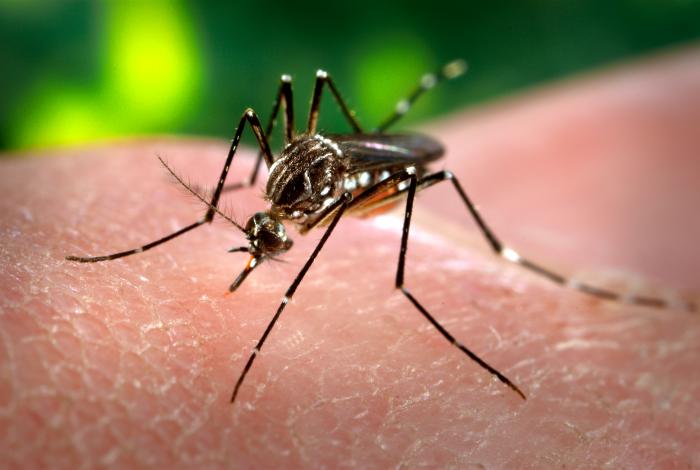- Aedes aegypti
Taxobox
name = "Stegomyia aegypti"

image_width = 250px
regnum =Animal ia
phylum =Arthropod a
subphylum =Hexapoda
classis =Insect a
subclassis =Pterygota
infraclassis =Neoptera
superordo =Endopterygota |
ordo = Diptera
familia =Culicidae
genus = "Stegomyia "
species = "S. aegypti"
binomial = "Stegomyia aegypti"
binomial_authority = (Linnaeus, 1762)The yellow fever mosquito, "Stegomyia aegypti" (="Aedes aegypti", ="Aedes (Stegomyia) aegypti"), is a
mosquito that can spread thedengue fever ,Chikungunya andyellow fever viruses, and other diseases as well. The mosquito can be recognized by white markings on legs and a marking of the form of alyre on thethorax . The mosquito originated from Africa [Mousson, L, Phylogeography of Aedes (Stegomyia) aegypti (L.) and Aedes (Stegomyia) albopictus (Skuse) (Diptera: Culicidae) based on mitochondrial DNA variations, Genetics Research (2005), 86: 1-11] but is now found in thetropics worldwide [cite journal |last= Womack|first= M.|year= 1993|title=The yellow fever mosquito, Aedes aegypti |journal= Wing Beats|volume= 5|issue= 4|pages= 4] .ystematics and name controversy
The yellow fever mosquito belongs to the tribe Aedini of the dipteran family
Culicidae . According to the recent analyses, it is a member of the genus "Stegomyia " [Reinert, J.F et al., Phylogeny and classification of Aedini (Diptera: Culicidae), based on morphological characters of all life stages. Zool. J. of the Linnean Society, 2004,142, 289–368] , which was traditionally treated as asubgenus of the genus "Aedes ". Applied biologists are often resistant to changes to the scientific names of organisms with which they work. The name change has annoyed many medical dipterists [A. Polaszek, Two words colliding: resistance to changes in the scientific names of animals – Aedes vs. Stegomyia, Trends Parasitol. 22 (2006), pp. 8–9] and the reaction of theJournal of Medical Entomology has even been to encourage authors dealing with aedine mosquitoes to continue to use the traditional names [http://www.entsoc.org/pubs/Periodicals/JME/mosquito_name_policy.htm] . However, the work of taxonomists is important and there are sound reasons to propose substantial modifications and to adopt new classifications and names, unless they are refuted based on clear scientific arguments [Marcondes,C.B. Taxonomic changes: disprove or accept them. Trends in Parasitology, Vol.23, 7, 2007] .Genomics
The
genome of this species of mosquito was sequenced by a consortium including scientists at theJ Craig Venter Institute and the University of Notre Dame, and published in 2007. The effort in sequencing itsDNA was intended to provide new avenues for research intoinsecticide s and possible genetic modification to prevent the spread of disease. This was the second mosquito species to have its genome sequenced in full (the first was "Anopheles gambiae "). The published data included the 1.38 billionbase pair s containing the insect's estimated 15,419protein encoding genes. The sequence indicates that the species diverged from "Drosophila melanogaster " (the common fruit fly) about 250 million years ago, and that "Anopheles gambiae" and this species diverged about 150 million years ago. [cite web|url=http://www.tigr.org/news/pr_05_17_07.shtml|title=Scientists at J. Craig Venter Institute Publish Draft Genome Sequence from Aedes aegypti, Mosquito Responsible for Yellow Fever, Dengue Fever | author=Heather Kowalski|date=2007-05-17 | publisher=J. Craig Venter Institute ] [Nene V, Wortman JR, Lawson D, Haas B, Kodira C, Tu ZJ, Loftus B, Xi Z, Megy K, Grabherr M, Ren Q, Zdobnov EM, Lobo NF, Campbell KS, Brown SE, Bonaldo MF, Zhu J, Sinkins SP, Hogenkamp DG, Amedeo P, Arensburger P, Atkinson PW, Bidwell S, Biedler J, Birney E, Bruggner RV, Costas J, Coy MR, Crabtree J, Crawford M, Debruyn B, Decaprio D, Eiglmeier K, Eisenstadt E, El-Dorry H, Gelbart WM, Gomes SL, Hammond M, Hannick LI, Hogan JR, Holmes MH, Jaffe D, Johnston JS, Kennedy RC, Koo H, Kravitz S, Kriventseva EV, Kulp D, Labutti K, Lee E, Li S, Lovin DD, Mao C, Mauceli E, Menck CF, Miller JR, Montgomery P, Mori A, Nascimento AL, Naveira HF, Nusbaum C, O'leary S, Orvis J, Pertea M, Quesneville H, Reidenbach KR, Rogers YH, Roth CW, Schneider JR, Schatz M, Shumway M, Stanke M, Stinson EO, Tubio JM, Vanzee JP, Verjovski-Almeida S, Werner D, White O, Wyder S, Zeng Q, Zhao Q, Zhao Y, Hill CA, Raikhel AS, Soares MB, Knudson DL, Lee NH, Galagan J, Salzberg SL, Paulsen IT, Dimopoulos G, Collins FH, Birren B, Fraser-Liggett CM, Severson DW (2007) Genome sequence of Aedes aegypti, a major arbovirus vector. Science 316:1718-23.]pread of disease and prevention
The CDC traveler's page on preventing dengue fever suggests using
mosquito repellent s that containDEET (N, N-diethylmetatoluamide). It also explains the following:# Although it may feed at any time, the mosquito bites humans only between a few hours after
dawn until an hour or so after sunset.
# The mosquito's preferred breeding areas are in areas ofstagnant water , such as flower vases, uncovered barrels, buckets, and discarded tires, but the most dangerous areas are wet shower floors and toilet tanks, as they allow the mosquitos to breed right in the residence. Research has shown that certain chemicals emanating from bacteria in water containers stimulate the female mosquitoes to lay their eggs. They are particularly motivated to lay eggs in water containers that have just the right amounts of specific fatty acids associated with bacteria involved in the degradation of leaves and other organic matter in water. The chemicals associated with the microbial stew are far more stimulating to discerning female mosquitoes than plain water, for example, or filtered water in which the bacteria once lived. [ [http://newswise.com/articles/view/542339/ Lay Your Eggs Here] Newswise, Retrieved on July 8, 2008.]ee also
*
Mosquito control References
External links
* [http://aaegypti.vectorbase.org/index.php VectorBase's genomic resource for "Aedes aegypti"]
* [http://gvcocks.homeip.net/Diptera/Culicidae/aedes%20egypti.htm A page that has an image of "Aedes aegypti"]
* [http://medent.usyd.edu.au/photos/aedes%20aegypti.htm "Aedes aegypti" page from University of Sydney, Australia]
* [http://www.microscopy-uk.org.uk/mag/indexmag.html?http://www.microscopy-uk.org.uk/mag/art98/aedrol.html "Aedes aegypti" and Dengue fever]
* [http://www.cdc.gov/ncidod/dvbid/dengue/ United States CDC page on dengue fever containing information on prevalence of "Aedes aegypti" worldwide and past efforts to eradicate it]
* [http://creatures.ifas.ufl.edu/aquatic/aedes_aegypti.htm "Aedes aegypti"] on theUF / IFAS Featured Creatures Web site
*
Wikimedia Foundation. 2010.
